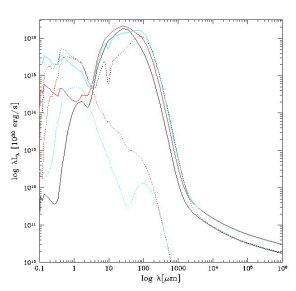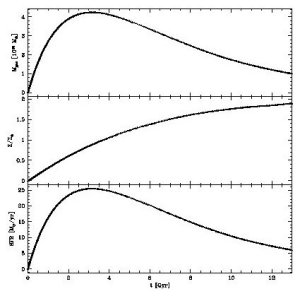LIBRARY OF GALAXY MODELS
Fits and templates
.![]() Work is in progress to build and make available a
spectral library of galaxy models computed with GRASIL. Below you can download the models fitting
the SEDs of some starburst and spiral galaxies, ULIRGs, GRB host galaxies, and some more sample models for one elliptical and three
spirals.
Work is in progress to build and make available a
spectral library of galaxy models computed with GRASIL. Below you can download the models fitting
the SEDs of some starburst and spiral galaxies, ULIRGs, GRB host galaxies, and some more sample models for one elliptical and three
spirals.
For the models presented
here, the inputs for GRASIL, i.e. the evolution of SFR, gas mass and
metallicity, are computed with a chemical evolution code with the following
parameters: exponential infall time-scale for gas
tinf [Gyr], normalized in order to accrete
a mass Minf [Msun] at age
tinf [Gyr]; Schmidt like star-formation
law
nMgask
(n in Gyr-1 for k=1);
Salpeter IMF (slope in mass=1.35) with boundary mass limits Mlow and Msup. The notation used for GRASIL
parameters is from the paper Silva L., Granato G.L., Bressan A.,
Danese L., 1998, ApJ, 509, 103 and Silva (1999).
The files of the chemical evolution and of the SEDs of the sample models
described below can be downloaded. Their formats are the following:
- Chemical evolution: (1) number of time step; (2) age of the
model in yr; (3) SFR in Msun/yr; (4) metallicity Z; (5) Mgas in Msun ; (6) Mstar in Msun; (7) Mtot in Msun; (8) Supernovae rate in yr-1.
- SED: (1) Wavelength in Å; (2) Cirrus emission; (3) Starlight
extincted by MCs only; (4) Starlight extincted; (5) MCs emission; (6) Total;
(7) Starlight unextincted; (8) Subcomponent unextincted; (9) Subcomponent
extincted.
Luminosities are in 1e30 ergs/s/Å; subcomponent in cols. 8,9 is bulge for
composite models otherwise=cols.7, 4 respectively.
Meaning of files:
name.che = input file for che_evo code;
name.sf = star formation history file (output of che_evo and input for
grasil);
name.bst = input file for grasil for a bulge+disk case;
name.par = input parameter file for grasil;
name.number = SED file (grasil output);
name.out = summary of some quantities of the model (grasil output).
![]() M82, ARP220, NGC6090, M51, M100, NGC6946, HR10
M82, ARP220, NGC6090, M51, M100, NGC6946, HR10
Download the models fitting the SEDs (files
name.number) of some starburst and spiral galaxies, presented in the paper Silva
et al. (1998) and Silva (1999) (and then updated following
successive GRASIL updates), as well as the input files to
run GRASIL (files name.sf and name.par). HR10 is a star forming ERO at z=1.44,
the other are nearby galaxies.
![]() ULIRGs
ULIRGs
We have analyzed the SEDs of a large sample of ULIRGs to get information on the
origin of their energy and their evolutionary status. To perform this work we
have fitted their NIR to radio SEDs with GRASIL.
The radio data and properties are in the paper Clemens, M.S., Vega, O.,
Bressan, A., Granato, G.L., Silva, L., Panuzzo, P., 2008, A&A, 477, 95, "Modeling
the spectral energy distribution of ULIRGs. I. The radio spectra"
The SED analysis is in
the paper Vega, O., Clemens, M.S., Bressan, A., Granato, G.L., Silva, L.
Panuzzo, P., 2007, A&A, submitted, arXiv:0712.1202, "Modeling the spectral energy
distribution of ULIRGs. II. The energetic environment and the dense interstellar
medium"
The ULIRGs we have considered are the following: UGC8058 IR14348-1447
IR12112+0305 IR05189-2524 UGC9913 IR08572+3915 UGC8696 IR15250+3609 IR10565+2448
UGC5101 IZW107 IR01364-1042 IR10173+0828 Arp299 UGC4881 CGCG436-30 IC1623
NGC1614 UGC8387 NGC7469 UGC2369 IIIZW35 IC5298 Arp148 NGC2623 Mrk331 NGC34
NGC5256 UGC6436 NGC6286 .
We provide the data and the fitting models in the following Tables, described in
Appendix B of Vega et al. 2007 :
sed_data.dat :
observed data for each galaxy in our sample. Wavelength (micron) and fluxes (Jy)
are in the observed frame.
sed_mod_tot.dat
:
model SEDs fitting the above data. The models include both starburst and AGN
components where necessary. Wavelengths (micron) and fluxes (Jy) are in the rest
frame. For this reason the second row provides the radial velocity (Km/s).
sed_mod_sb.dat :
starburst component alone of the fitting model. Same format as the full
model.
![]() SED templates for Gamma-Ray Burst
host galaxies by Michal Michalowski et al.
SED templates for Gamma-Ray Burst
host galaxies by Michal Michalowski et al.
SED template database published in Michalowski et al. (2008, ApJ, 672, 817)
and produced using GRASIL.
The SEDs can be downloaded from
http://archive.dark-cosmology.dk/ . They corresponds to GRB host
galaxies and hence can be used to fit the observations of young, star-forming
galaxies.
![]() ELLIPTICAL MODEL
ELLIPTICAL MODEL
Local elliptical
galaxies show very homogeneus properties and their SED is dominated by old
stellar populations. Indeed in the monolithic galaxy formation scenario, they
are believed to have formed at early times, at redshift >2, with a short
(~1Gyr) and intense star-formation phase, followed by pure stellar evolution. During
the star-forming phase dust is expected to play a role shifting the SED from
the optical-UV to the FIR-submm spectral region, as observed for local
starbursts. Any model following this kind of evolutionary history reproduces
the average observed SED of local giant ellipticals.
Below the spectral
evolution of a sample
model is plotted (left), as resulting from its star-formation history (elli1.sf, right). The SED plotted are for 0.1, 0.2, 0.4, 0.8, 1.5, 13 Gyr.
SED
files are elli1_age.0 with age in Gyr:
0.1,
0.2,
0.4,
0.8,
1.5,
2,
3,
4,
5,
8,
11,
13
STAR-FORMATION HISTORY PARAMETERS (elli1.che):
tinf =0.1 Gyr, Minf =1e12 Msun at age
tinf =1 Gyr,
n=2 Gyr-1, k=1;
Mlow= 0.15 and Msup =120 Msun.
SPECTRO-PHOTOMETRIC PARAMETERS (elli1.par):
fmc= 1 with ongoing SF, 0 afterwards;
Mmc= 1e6 Msun , rmc= 16 pc,
to= 0.1 Gyr; d=0.45×Z (i.e. proportional to the metallicity and equal to the solar
neighborhood value of 1/110 at solar Z); King geometry with core radii
rc
both for stars and dust of 0.5 Kpc
with ongoing SF, while 0.5 and 6 Kpc respectively afterwards.
|
|
|
N.B.: in the case of composite (bulge + disk) geometry (igeo=-1), in addition to the .sf and .par files as input for grasil, grasil looks also for a file mod_name.bst (that gives a tabulation of the SFR ongoing on the bulge over the total of the model galaxy as a function of its age)
![]() SPIRAL MODELS
SPIRAL MODELS
Spiral galaxies are
much more complex systems as compared to ellipticals. Their SEDs show
variations of a few orders of magnitudes in the IR and to a less extent in the
optical-UV spectral region, depending on the SFR, distribution of stars and
ISM, and inclination angle with respect to the line of sight. According to the
properties of their stellar populations and the amount and chemical abundance
of their ISM, local spirals are generally believed to have undergone a slow and
continuous evolution, with the ratio of the average past SFR to the current one
~ 5-10. They can be broadly classified into the morphological classes Sa, Sb,
Sc according to the bulge/disk magnitude ratio (as a function of the
wavelength), and corresponding to an average SED. To have an indication of the
morphological class for our models, we have considered the classification in
the V band by Solanes et al., 1989, AJ, 98, 798.
![]() Sa model
Sa model
SEDs along different line of sights (from face-on to edge-on) and the
angle-averaged one for a 13 Gyr sample model:
spia.0,
spia.15,
spia.30,
spia.45,
spia.60,
spia.75,
spia.90,
spia.spe
STAR-FORMATION HISTORY
(spia.che,
spia.sf ,
spia.bst):
tinf =2 Gyr, Minf =1.5e11 Msun at age
tinf =13 Gyr,
n=2 Gyr-1, k=1; Mlow= 0.10 and Msup =100 Msun.
SPECTRO-PHOTOMETRIC PARAMETERS (spia.par):
fmc= 0.5,
Mmc= 1e6 Msun , rmc= 14 pc,
to= 0.018 Gyr; d=0.45×Z (i.e. proportional to the metallicity and equal to the solar
neighborhood value of 1/110 at solar Z); composite King+double exponential
geometry with radii rc = 0.3 Kpc,
rd = 5 Kpc,
zd
= 0.5 Kpc.
![]() Sb model
Sb model
SEDs along
different line of sights (from face-on to edge-on) and the angle-averaged one
for a 13 Gyr sample model:
spib.0,
spib.15,
spib.30,
spib.45,
spib.60,
spib.75,
spib.90,
spib.spe .
The SED plotted below are for 1, 3, 5, 7, 10, 13 Gyr.
STAR-FORMATION HISTORY
(spib.che,
spib.sf,
spib.bst):
tinf =4 Gyr, Minf =1.5e11 Msun at age
tinf =13 Gyr,
n=0.6 Gyr-1, k=1; Mlow= 0.10 and Msup =100 Msun.
SPECTRO-PHOTOMETRIC PARAMETERS (spib.par):
fmc= 0.5,
Mmc= 1e6 Msun , rmc= 14 pc,
to= 0.018 Gyr; d=0.45×Z (i.e. proportional to the metallicity and equal to the solar
neighborhood value of 1/110 at solar Z); composite King+double exponential
geometry with radii rc = 0.3 Kpc,
rd = 5 Kpc,
zd
= 0.5 Kpc.
|
|
|
![]() Sc model
Sc model
SEDs along
different line of sights (from face-on to edge-on) and the angle-averaged one
for a 13 Gyr sample model:
spic.0,
spic.15,
spic.30,
spic.45,
spic.60,
spic.75,
spic.90,
spic.spe .
STAR-FORMATION HISTORY
(spic.che,
spic.sf,
spic.bst):
tinf =4 Gyr, Minf =1.5e11 Msun at age
tinf =13 Gyr,
n=0.05 Gyr-1, k=1;
Mlow= 0.10 and Msup =100 Msun.
SPECTRO-PHOTOMETRIC PARAMETERS (spic.par):
fmc= 0.5,
Mmc= 1e6 Msun , rmc= 14 pc,
to= 0.018 Gyr; d=0.45×Z (i.e. proportional to the metallicity and equal to the solar
neighborhood value of 1/110 at solar Z); composite King+double exponential
geometry with radii rc = 0.3 Kpc,
rd = 5 Kpc,
zd
= 0.5 Kpc..



